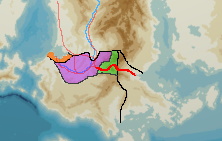Difference between revisions of "Southern Phaswa Railway"
Matan-matika (talk | contribs) |
Protondonor (talk | contribs) (cats) |
||
| Line 34: | Line 34: | ||
The Qonklese massively built out the rail capacity on passes farther north, after losing this territory and cooling relations. | The Qonklese massively built out the rail capacity on passes farther north, after losing this territory and cooling relations. | ||
[[Category:History of Quaxin Xun]] [[Category:History of Zaizung]] | |||
Revision as of 22:40, 5 September 2022
The Southern Phaswa Railway is a railway built through the Phaswa Mountains in the 19th C between what is now Quaxin Xun and Zaizung, though then all of it was part of Olboros Dynasty Qonklaks. It is currently used for both freight and passenger service.
History
Kyaiqjẽlyauq War
The Ji River valley is a central part of Qonklaks within the Phaswa Mountains, and was historically a pivotal stopping off point between the east and west parts of Qonklaks. In the mid 19th C, the Olboros government realized its potential use if they controlled the whole river.
They fought the Kyaiqjẽlyauq War in 1851-1853, to conquer the whole river from Quaxin Xun, up to the port of <port city>.
After the war, massive amounts of funds were dropped into canalizing the river, installing locks at all portages up through the Ji valley, and dredging out the port. To secure this, they also settled a lot of ethnic Qonklese, especially in <port city>.
Kyaiqbùmyè War
With the rise of the steam engine during the Industrial Revolution, it became increasingly clear that Qonklaks needed to build a railway through the Phaswa Mountains to connect the east and west sides of Qonklaks. Shipping around Quaxin Xun took too long, and was increasingly expensive with the rise of Bosato and Nyatol controlling the straits between Manea and what is now Zaizung.
Quickly on the heels of the Kyaiqjẽlyauq, the Olboros government moved a bunch of engineers to the newly conquered parts of the Ji River Valley. The engineers realized that the flattest pass would be between that area and Zaizung's old northern capital, but some of that territory in the pass was Xuni.
To gain financing and the element of surprise, the Olboros government took out loans from international banking centers claiming to do some more of the ongoing canalization work on the Ji River, but instead used those funds to wage a second war against Quaxin Xun, the Kyaiqbùmyè War of 1858-1861.
Construction of the Railway
<Insert labor abuses here>
Growth of <Port City>
Fall of the Olboros Dynasty
Zaizungese forces were able to hold the pass in the 1917 war.
Pangyeoun War
Modern times
After the Pangyeoun War. Qonklaks ceded all areas conquered in the Kyaiqjẽlyauq and Kyaiqbùmyè Wars back to Quaxin Xun, except for the area around <port city>, which was XX% ethnically Qonklese.
This railway is a vital east-west hub between Quaxin Xun and Zaizung.
The Qonklese massively built out the rail capacity on passes farther north, after losing this territory and cooling relations.
